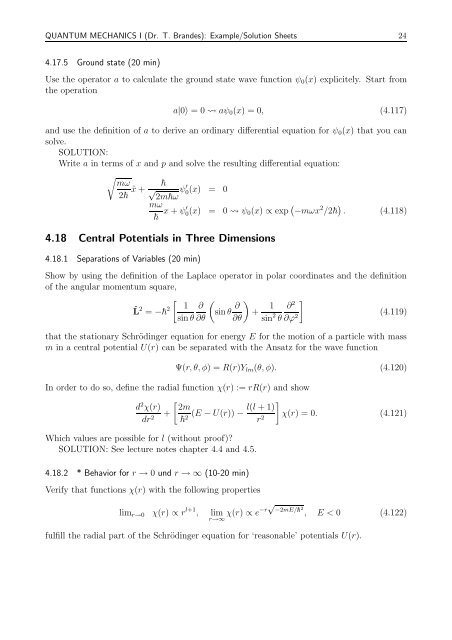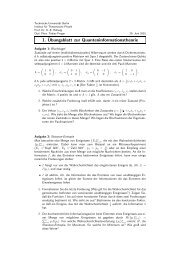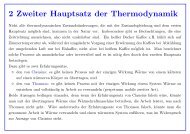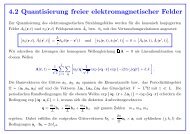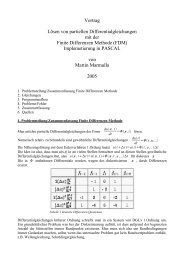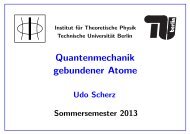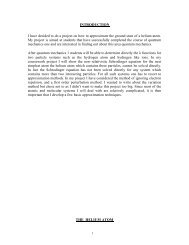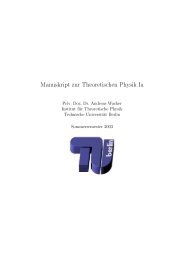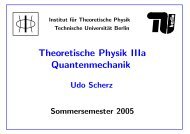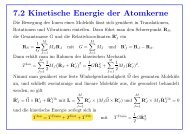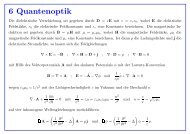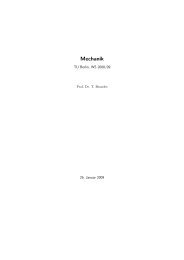1.1 The Radiation Laws and the Birth of Quantum Mechanics
1.1 The Radiation Laws and the Birth of Quantum Mechanics
1.1 The Radiation Laws and the Birth of Quantum Mechanics
You also want an ePaper? Increase the reach of your titles
YUMPU automatically turns print PDFs into web optimized ePapers that Google loves.
QUANTUM MECHANICS I (Dr. T. Br<strong>and</strong>es): Example/Solution Sheets 24<br />
4.17.5 Ground state (20 min)<br />
Use <strong>the</strong> operator a to calculate <strong>the</strong> ground state wave function ψ 0 (x) explicitely. Start from<br />
<strong>the</strong> operation<br />
a|0〉 = 0 aψ 0 (x) = 0, (4.117)<br />
<strong>and</strong> use <strong>the</strong> definition <strong>of</strong> a to derive an ordinary differential equation for ψ 0 (x) that you can<br />
solve.<br />
SOLUTION:<br />
Write a in terms <strong>of</strong> x <strong>and</strong> p <strong>and</strong> solve <strong>the</strong> resulting differential equation:<br />
√ mω<br />
2 ˆx +<br />
<br />
√<br />
2mω<br />
ψ ′ 0 (x) = 0<br />
mω<br />
x + ψ′ 0(x) = 0 ψ 0 (x) ∝ exp ( −mωx 2 /2 ) . (4.118)<br />
4.18 Central Potentials in Three Dimensions<br />
4.18.1 Separations <strong>of</strong> Variables (20 min)<br />
Show by using <strong>the</strong> definition <strong>of</strong> <strong>the</strong> Laplace operator in polar coordinates <strong>and</strong> <strong>the</strong> definition<br />
<strong>of</strong> <strong>the</strong> angular momentum square,<br />
[ ( 1<br />
ˆL 2 = − 2 ∂<br />
sin θ ∂ )<br />
+ 1 ]<br />
∂ 2<br />
sin θ ∂θ ∂θ sin 2 (4.119)<br />
θ ∂ϕ 2<br />
that <strong>the</strong> stationary Schrödinger equation for energy E for <strong>the</strong> motion <strong>of</strong> a particle with mass<br />
m in a central potential U(r) can be separated with <strong>the</strong> Ansatz for <strong>the</strong> wave function<br />
Ψ(r, θ, φ) = R(r)Y lm (θ, φ). (4.120)<br />
In order to do so, define <strong>the</strong> radial function χ(r) := rR(r) <strong>and</strong> show<br />
[ ]<br />
d 2 χ(r) 2m<br />
l(l + 1)<br />
+ (E − U(r)) − χ(r) = 0. (4.121)<br />
dr 2 2 r 2<br />
Which values are possible for l (without pro<strong>of</strong>)<br />
SOLUTION: See lecture notes chapter 4.4 <strong>and</strong> 4.5.<br />
4.18.2 * Behavior for r → 0 und r → ∞ (10-20 min)<br />
Verify that functions χ(r) with <strong>the</strong> following properties<br />
lim r→0 χ(r) ∝ r l+1 , lim<br />
r→∞<br />
χ(r) ∝ e −r√ −2mE/ 2 , E < 0 (4.122)<br />
fulfill <strong>the</strong> radial part <strong>of</strong> <strong>the</strong> Schrödinger equation for ‘reasonable’ potentials U(r).


